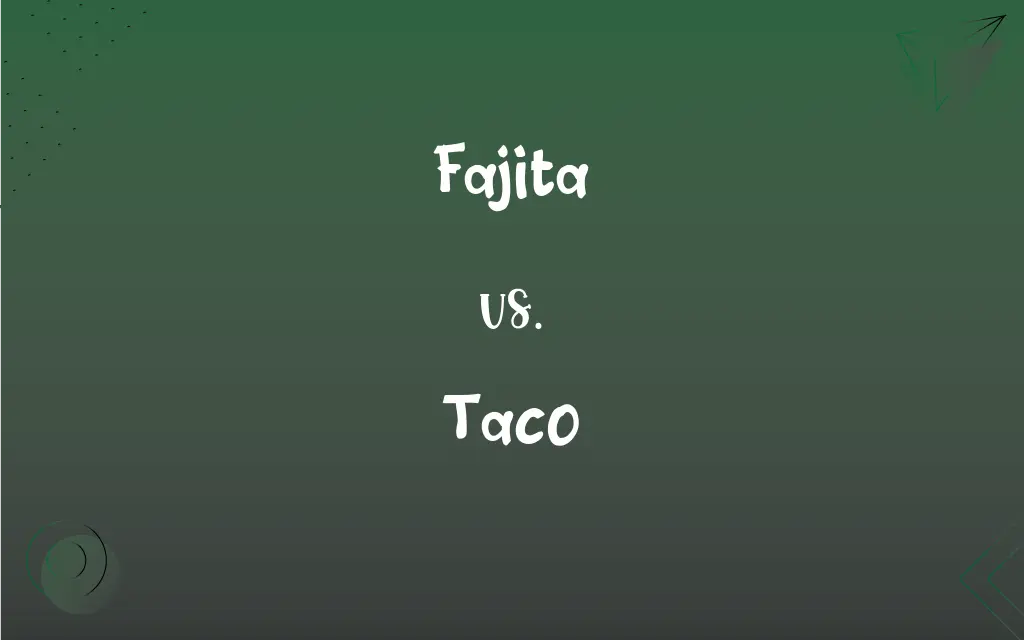Fajita vs. Taco: What's the Difference?
Edited by Aimie Carlson || By Janet White || Published on March 14, 2024
Fajitas are a Tex-Mex dish made with grilled meat and served on a flour or corn tortilla, while tacos are a traditional Mexican dish consisting of a folded or rolled tortilla filled with various ingredients.

Key Differences
Fajitas originate from the Tex-Mex cuisine, traditionally featuring grilled skirt steak, though chicken and shrimp are also popular. Tacos, a staple in Mexican cuisine, can be filled with a wide variety of ingredients, including beef, chicken, seafood, vegetables, and more. Both dishes use tortillas as their base, but their preparation and presentation differ significantly.
The term "fajita" specifically refers to the style of meat preparation and serving. Initially, it was associated with skirt steak, the cut of beef first used for this dish. Over time, fajitas have evolved to include other types of meat and vegetables, all typically served with grilled onions and bell peppers. Tacos, on the other hand, are more about the tortilla and its fillings, with a broader range of possible ingredients and less emphasis on the cooking method of the fillings.
Fajitas are usually served as a deconstructed meal where the meat and vegetables are presented on a sizzling platter, accompanied by tortillas and various toppings like sour cream, guacamole, and salsa, allowing diners to assemble their fajitas according to their preferences. Tacos are served pre-assembled, with the fillings already placed inside folded or rolled tortillas, and are often garnished with cilantro, onions, and lime.
The serving style of fajitas lends itself to a more interactive dining experience, as each person constructs their fajita from a communal platter of ingredients. Tacos are typically served individually, making them a convenient and quick meal option, easily customizable but with less emphasis on diner interaction.
Both fajitas and tacos can be made with flour or corn tortillas, fajitas are more commonly associated with flour tortillas in the United States, reflecting their Tex-Mex origins. Tacos are traditionally made with corn tortillas in Mexico, though flour tortillas are also used, especially in Northern Mexican and Tex-Mex cuisines.
ADVERTISEMENT
Comparison Chart
Origin
Tex-Mex
Mexican
Base
Flour or corn tortilla
Flour or corn tortilla
Typical Fillings
Grilled meat (especially skirt steak), onions, bell peppers
Wide variety, including beef, chicken, seafood, vegetables
Serving Style
Deconstructed, with ingredients served separately
Pre-assembled, with fillings already in the tortilla
Tortilla Type
Commonly flour in the US
Traditionally corn in Mexico, but flour is also used
ADVERTISEMENT
Fajita and Taco Definitions
Fajita
Served deconstructed for self-assembly.
Our fajita platter included separate servings of grilled chicken, peppers, and onions.
Taco
A traditional Mexican dish with a folded tortilla and fillings.
We enjoyed tacos filled with grilled fish and fresh salsa.
Fajita
A Tex-Mex dish of grilled meat served on a tortilla.
The restaurant's fajitas came with sizzling steak and warm flour tortillas.
Taco
Often garnished with cilantro, onions, and lime.
A squeeze of lime and a sprinkle of onions completed the perfect taco.
Fajita
Often accompanied by bell peppers and onions.
The fajitas were served with a colorful mix of sautéed peppers and onions.
Taco
Can be made with a variety of fillings.
Tonight's tacos feature a delicious mix of seasoned ground beef and cheese.
Fajita
Traditionally made with skirt steak.
We marinated skirt steak for our homemade fajitas tonight.
Taco
Traditionally made with corn tortillas in Mexico.
Authentic Mexican tacos are best with soft, handmade corn tortillas.
Fajita
Usually served with flour tortillas in the US.
She wrapped the grilled veggies and meat in a soft flour tortilla to make her fajita.
Taco
Served pre-assembled.
The street vendor handed us a taco filled with carnitas and topped with cilantro.
Fajita
A dish consisting of strips of marinated meat or vegetables that are grilled over an open fire and served in a tortilla, usually with spicy condiments.
Fajita
A Tex-Mex dish of strips of spicy marinated meat and/or vegetables in a soft flour tortilla, often served with salad or a savoury filling.
FAQs
What's the best tortilla for tacos?
The best tortilla for tacos depends on personal preference and the specific type of taco being made; traditionally, corn tortillas are used in Mexico, but flour tortillas are also popular, especially in Tex-Mex cuisine.
How do you serve fajitas?
Fajitas are served deconstructed, with the meat and vegetables on a sizzling platter, alongside tortillas and toppings for diners to assemble their own.
Can you make fajitas or tacos with fish?
Yes, both fajitas and tacos can be made with fish as an alternative to traditional meats like beef or chicken.
Is there a vegetarian option for fajitas and tacos?
Yes, both dishes can be made vegetarian by substituting meat with grilled vegetables, beans, or meat alternatives.
Are fajitas considered authentic Mexican food?
Fajitas are more Tex-Mex than authentically Mexican, originating from the culinary fusion along the Texas-Mexico border.
How do tacos differ in Mexico compared to the United States?
In Mexico, tacos are more likely to be made with soft corn tortillas and simple, fresh ingredients, while in the United States, there's a broader variation including hard-shell tacos and more diverse fillings.
What is the origin of the word "fajita"?
The word "fajita" originally referred to the cut of beef used to make the dish, which is the skirt steak, and it means "little belt" in Spanish, referring to the cut's appearance.
What are common toppings for tacos?
Common toppings include cilantro, diced onions, salsa, cheese, lettuce, and lime wedges.
What makes a dish a fajita?
A dish is considered a fajita if it involves grilled meat served on a tortilla, traditionally accompanied by grilled onions and bell peppers, and meant for diner assembly.
What are some common misconceptions about fajitas and tacos?
A common misconception is that fajitas are a traditional Mexican dish, when in fact, they are Tex-Mex. Another is that tacos always come in a hard shell, whereas traditional Mexican tacos are served in soft corn tortillas.
What are some tips for making restaurant-quality fajitas and tacos at home?
For fajitas, marinating the meat and vegetables can add depth of flavor. Using a cast-iron skillet can mimic the high heat of restaurant grills. For tacos, using freshly made tortillas and a variety of fresh toppings can elevate the homemade version to restaurant quality.
Can fajitas be made without meat?
Absolutely, vegetarian fajitas use grilled vegetables such as bell peppers, onions, mushrooms, and zucchini as the main filling.
What distinguishes the flavors between fajitas and tacos?
The distinct flavor of fajitas comes from the grilled meat and vegetables, often marinated in spices and lime juice. Tacos, while also flavorful, can vary greatly depending on the fillings, with each type of taco having its own unique seasoning and garnish.
What is the significance of the tortilla in Mexican cuisine?
The tortilla is a staple in Mexican cuisine, serving as the foundational element for many dishes, including tacos. It's not just a food item but a cultural symbol, representing the blending of indigenous and Spanish influences through its corn and flour variations.
How important are fresh ingredients in making fajitas and tacos?
Fresh ingredients are crucial in making both fajitas and tacos, as they rely on the quality of the meat, vegetables, and tortillas for their flavor. Fresh garnishes like cilantro, lime, and salsa significantly enhance the taste and authenticity of these dishes.
How do the nutritional values of fajitas and tacos compare?
The nutritional values of both can vary widely based on the ingredients used. Fajitas, with grilled meat and vegetables, can be leaner, especially if made with chicken or seafood and less cheese or sour cream. Tacos' nutritional content can range from light, when filled with lean meats and fresh vegetables, to more calorie-dense, when loaded with cheese, sour cream, or fried fillings.
Why are tacos more popular globally than fajitas?
Tacos have a broader global appeal due to their versatility, ease of eating (being pre-assembled), and the wide variety of available fillings, catering to many tastes and dietary preferences. Their simple yet flavorful profile makes them adaptable to many regional tastes, contributing to their worldwide popularity.
In what ways do fajitas and tacos reflect the cultural diversity of their regions of origin?
Fajitas reflect the cultural blending of Tex-Mex cuisine, combining Mexican culinary traditions with Texan ranching culture. Tacos, on the other hand, showcase the regional diversity of Mexico, with each area having its own unique styles and fillings, reflecting the local ingredients and culinary practices.
Can fajitas and tacos fit into a vegetarian or vegan diet?
Yes, both can be adapted to vegetarian or vegan diets by substituting meat with plant-based proteins, such as beans, tofu, or tempeh, and using dairy-free cheese and sour cream alternatives.
How have fajitas and tacos evolved over time?
Both dishes have evolved significantly, incorporating a wider variety of ingredients and flavors as they've become popular worldwide. Fajitas have expanded beyond skirt steak to include chicken, shrimp, and vegetarian options, while tacos have seen an explosion of creativity, from gourmet and fusion varieties to traditional regional recipes gaining international fame.
About Author
Written by
Janet WhiteJanet White has been an esteemed writer and blogger for Difference Wiki. Holding a Master's degree in Science and Medical Journalism from the prestigious Boston University, she has consistently demonstrated her expertise and passion for her field. When she's not immersed in her work, Janet relishes her time exercising, delving into a good book, and cherishing moments with friends and family.
Edited by
Aimie CarlsonAimie Carlson, holding a master's degree in English literature, is a fervent English language enthusiast. She lends her writing talents to Difference Wiki, a prominent website that specializes in comparisons, offering readers insightful analyses that both captivate and inform.































































